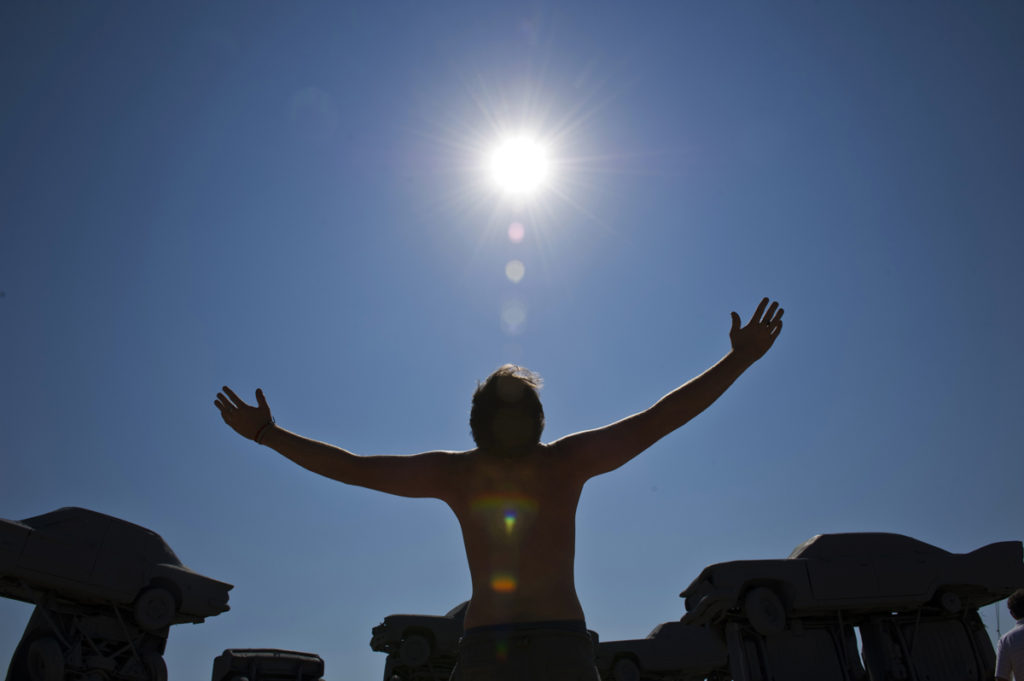Glossary of Astronomical Terms
Jupiter and Venus, planets within our solar system, form a celestial triangle with Earth’s Moon above the Brooklyn Bridge in New York City on December 1, 2008. ©Mark D Phillips
Astronomical Terms used in kidseclipse.com
annular eclipse
a solar eclipse in which a ring, or annulus, of the Sun¹s photosphere remains visible.
Apollo 11
the first manned spacecraft to land on the Moon in 1969, when Neil Armstrong said, “One small step for man, one giant leap for mankind.”
asteroid
one of the thousands of tiny planets orbiting the Sun mostly located between the orbits of Mars and Jupiter.
asteroid belt
a wide gap between the orbits of Mars and Jupiter where most asteroids can be found.
astronomer
a wide gap between the orbits of Mars and Jupiter where most asteroids can be found.
Astronomy
the science that deals with the universe beyond Earth¹s atmosphere.
corona
the faint, white light seen around the Sun during a solar eclipse.
axis
an imaginary line around which an object spins.
Bailey’s Beads
a chain of several bright “beads” of white light, visible just before and just after a total solar eclipse.
celestial
pertaining to the sky; heavenly.
chromosphere
a layer in the Sun and many other starts just above the photosphere.
craters
bowl-shaped holes found on the Moonís surface.
comet
an object made of dust and frozen gases that orbits the Sun.
corona
the faint, white light seen around the Sun during a solar eclipse.
crescent
the figure of the Moon during its first and last quarter, resembling a segment of a ring with pointed ends.
cycle
a period of time in which events repeat themselves in the same order.
Earth
the third planet from the Sun, our world.
eclipse, lunar
the passing of the Moon into the Earth¹s shadow.
eclipse, solar
the passing of the Moon¹s shadow across the Earth.
fireball
a very bright meteor
galaxy
a group of stars, gas and dust.
Galileo
a famous Italian astronomer (1564-1642) who was the first person to use a telescope to look at the sky.
gas
a state of matter.
gibbous
a phase of the Moon in which more than half of the side we see is illuminated.
half moon
the first-quarter or third-quarter phase, when half the visible side of the Moon is illuminated.
helium
a gas that’s lighter-than-air, with the symbol He and atomic number 2, the first in the noble gas group in the periodic table.
hydrogen
a gas with the symbol H and atomic number 1, the most abundant chemical substance in the Universe.
lunar
having to do with the Moon.
lunar eclipse
occurs when the Earth passes between the Sun and the Moon.
maria
smooth places on the Moon¹s surface; seas.
meteor
a streak of light in the sky caused by a chunk of rock burning up in Earth’s air.
meteorite
a meteoroid that lands on a planet or a satellite.
meteoroids
chunks of iron, nickel, and other materials that move through space.
meteor shower
the appearance of many meteors during a short period of time as the Earth passes through a comet’s orbit.
orbit
the path of one object in space around another object.
penumbra
the larger shadow cast by the Moon during a solar eclipse.
phase
the shape the Moon appears to be as seen from Earth.
photosphere
the surface of the Sun.
planets
the main bodies in the solar system that revolve around the Sun.
revolution
the movement of one object around another.
rotation
the spinning of an object.
satellite
a smaller object that revolves around a larger object.
shadow bands
light and dark bands that appear to sweep across the ground before and after a total solar eclipse.
shooting stars
meteors
solar eclipse
occurs when the Moon passes between the Earth and the Sun.
solar flares
bright areas in the Sun’s atmosphere from which hot gases shoot out.
solar prominences
bright areas in the Sun’s atmosphere from which hot gases shoot out.
solar system
the nine planets, their moons, and the Sun.
sunspots
dark spots on the Sun.
telescope
an instrument that makes distant objects appear closer and larger.
umbra
the darker, smaller shadow cast by the Moon during a total solar eclipse.
Lesson Plan Outline for Kidseclipse
This site has been designed to give your class an overview of astronomy and help them understand why a Total Solar Eclipse can happen. Each section leads with a simple question which is answered through the use of words, pictures, animations and activities. Each section requires approximately 5 minutes, each activity varies.
Dolores Peterson was a New York City School Teacher in Community School District 3 for nine years when she produced this lesson plan for Kidseclipse. She has a Masters in Education from the City University of New York.
How do the Sun, the Earth, and the Moon move?
Click Here to view complete Lesson Plan Outline for Kidseclipse


